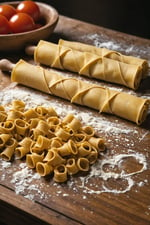Create a vibrant and detailed illustration showcasing a variety of traditional pasta types. The scene should be set in a cozy Italian kitchen or a rustic pasta workshop, filled with the rich cultural ambiance of Italy. Highlight each type of pasta with clear visual representation, from the preparation of the dough to the final shapes. Include both common and unique pasta varieties, showcasing their distinct characteristics and origins:
1. **Pasta Dough Preparation:** Begin with a scene of a cook preparing the pasta dough. Show a wooden workbench dusted with flour, where ingredients like eggs, flour, and water are being mixed and kneaded into a smooth, elastic dough. Capture the hands-on process of kneading the dough, the rich, golden color of the mixture, and the tools used, such as a rolling pin and a pasta cutter.
2. **Sheet Pasta (Fettuccine and Lasagna):** Illustrate the process of rolling out the dough into thin sheets. Show the dough being fed through a pasta machine or rolled out by hand into long, even sheets. Highlight the process of cutting these sheets into fettuccine ribbons and wide lasagna strips. Display the fettuccine arranged in neat nests and lasagna sheets laid flat, ready for cooking or drying.
3. **Ribbon Pasta (Tagliatelle and Pappardelle):** Visualize the rolling and cutting of pasta into wider ribbons. Show tagliatelle, slightly narrower, and pappardelle, broader and thicker. Include details of the pasta being dusted with flour to prevent sticking and neatly coiled into bundles. Capture the subtle differences in width and texture between these types.
4. **Tube Pasta (Penne and Rigatoni):** Depict the shaping of tubular pasta using a pasta extruder or by hand. Show the process of forming penne with their diagonal cuts and ridged surface, and rigatoni with their wider diameter and straight cuts. Display these pasta types in a bowl, highlighting their ability to hold sauce inside their ridges and hollow centers.
5. **Stuffed Pasta (Ravioli and Tortellini):** Illustrate the process of making stuffed pasta. Show small squares of dough being filled with mixtures like ricotta, spinach, or meat for ravioli. Capture the folding and sealing of the dough into neat parcels. For tortellini, depict the dough being wrapped around the filling and twisted into ring shapes. Include the process of crimping the edges to seal the fillings inside.
6. **Shaped Pasta (Fusilli and Farfalle):** Visualize the creation of shaped pasta. Show fusilli being twisted into spiral shapes using a special tool or by hand. For farfalle, depict the cutting of small rectangles of dough and pinching them in the center to create bow-tie shapes. Highlight the intricate details and playful forms of these pastas.
7. **Long Pasta (Spaghetti and Linguine):** Depict the making of long, thin pasta strands. Show spaghetti being stretched and cut into uniform lengths. Illustrate the slight flatness of linguine, with its edges slightly thicker than the middle. Display these pastas hanging to dry on a drying rack or coiled into nests.
8. **Specialty Pasta (Orecchiette and Cavatelli):** Conclude with unique regional pasta types. Show orecchiette, small ear-shaped pasta, being formed by pressing with the thumb or a special tool. Illustrate cavatelli, small rolled pasta with a hollow center, created by rolling pieces of dough with fingers. Highlight the distinctive shapes and textures that make these pastas stand out.
9. **Cultural Ambiance and Surroundings:** Add a backdrop that reflects the warm, inviting atmosphere of Italian cuisine. Include details like baskets of fresh ingredients (tomatoes, basil, garlic), a rolling pin, a pasta drying rack, and a cozy kitchen setting with rustic wooden shelves and hanging herbs. Capture the essence of Italian culinary tradition and the joy of handmade pasta.
Use warm, earthy tones and detailed textures to bring each type of pasta to life, from the smooth, golden dough to the intricate, finished shapes. Each type should be clearly labeled to guide the viewer through the variety of pasta styles and the craftsmanship involved in their creation.
This prompt should provide a vivid and engaging depiction of various pasta types, showcasing their unique forms and the artisanal process behind each one, set in a charming Italian kitchen environment.



